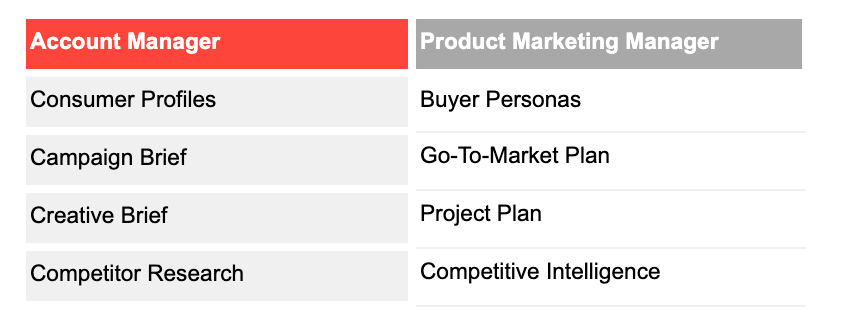Early on in my marketing career, I knew that at some point I wanted to work at an agency, I considered it a marketing right of passage, I thought that without that key experience, I couldn’t really call myself a marketer.
Having spent an incredibly dynamic, fast-paced, hectic, and rewarding year at a wildly creative branding and advertising agency as an Account Manager, I can proudly say that I’m able to cross that experience off my marketing bucket list. I learned a lot during that year—more than I ever expected. One thing I learned immediately following that year was that, like me, a lot of Account Managers (AMs) want to know how they too can transition from Account Manager to Product Marketing Manager (PMM).
Whether due to burnout or the desire to pursue a new adventure, I was surprised by how often AMs approached me asking for the secret to my switch from AM to PMM. These AMs wondered how they could possibly apply to a PMM position, without the relevant experience or necessary PMM skills. What I hope to show Account Managers in this article is that you’ve been developing valuable Product Marketing skills throughout your AM journey—you just haven’t realized it yet. You may not (yet) possess the technical know-how to be a certified Product Marketing expert (fortunately, there’s a course for that), but you almost certainly possess the foundational soft skills needed to be competitive for PMM roles.
Let’s take a look at three of those skills in more detail.
Skill 1: Translating client problems into marketing solutions
I’m sure many AMs have experienced being approached (sometimes frantically) by their client with an urgent, and oftentimes vague, request for support with a time-sensitive project. The client has been asked by their boss to accomplish a specific goal or reach a specific metric, but with little direction as to how, other than to go to the agency partner for help.
When confronted with this problem as an AM, it’s often your job to contextualize that problem, understand it, work with internal creatives to conceptualize a solution, and then ‘chunk’ that solution into tangible deliverables with the help of your Project Managers and creative team.

As a PMM, you’re often asked to do the exact same thing, your customers, and not your clients, often come to you with vague problems that they want you to help solve. Sometimes you have to do a lot of digging to uncover those problems, as customers aren’t always fully aware or able to communicate the problem effectively, but one way or another it becomes your job to help solve those problems. Next, assisted by input from customers (both existing and potential), market research, input from Sales, and competitive intelligence, you work with the Product Team to conceptualize a solution. Product Managers, working closely with you, will chunk that solution into various projects and iterations that will eventually turn into a tangible solution in the form of a new feature or service.
This contextualize, understand, conceptualize, chunk, and deliver process may appear on its surface to be vastly different depending on whether you’re an AM or a PMM, but it really is fundamentally the same.
Skill 2: Communicating with empathy and clarity
During my time as an AM I often chatted with clients about the professional and personal impact of the problems the agency was helping them to solve. Whether the client was an independent business owner, whose livelihood depended on the success of their business, or they were an employee of a larger organization, those problems impacted them in a variety of ways. Some felt the pressure of solving a problem they’d been assigned by their manager, while others spoke with excitement about the value the solution to their problem would bring. After sharing those feelings, these clients expected a clear and concise solution or way forward.

A good Account Manager makes their client’s problems (or opportunities) their own, and the best way to demonstrate that shared ownership is through empathy. It’s vital that Account Managers put themselves in the shoes of their client, or their client’s customers, to fully understand the problem or opportunity they’re facing. It’s arguably even more crucial to show them that you care and understand as much as they do. Demonstrating this care tells the client that you get it, that you’re there to help because you know how they feel, and that you’re the best person to help, because of that shared understanding.
Equally important for an AM is to then share and communicate your recommended solution clearly and concisely - clients, and more importantly, their customers, don’t have time for fluff. They want to know what you plan on doing, how you plan on doing it, and why it’s the right course of action—in as few words and in the shortest amount of time possible. They’re busy people, any time wasted getting from problem to solution is wasting billable hours, which, for the AM and the agency may feel like a monetary win, but in the long term it often has a detrimental impact on the agency-client relationship.
As a PMM, you have to demonstrate empathy and those same methods of effective communication to help your marketing and sales teams sell your solution. You have to communicate to your customers that your organization understands how important their problem or opportunity is. Which of the following pitches do you think is more effective:
“Our project management software will help you save time and money.”
Or...“We know how frustrating and overwhelming it can feel to track all the moving parts, budgets, and timelines of complex projects. Let our project management software put you back in control of your projects and give you the tools needed to remove stress from the process and save you valuable time and money.”
Immediately, the second pitch stands out because it tells the customer you know how they feel when they have to manage complex projects. Without the necessary tools, they’ll feel stressed or helpless, like the project is slowly slipping away from them. Making that powerful connection through empathy shows the customer that you can be trusted because you know exactly how they’re feeling.
The second pitch also speaks to how your solution will put your customer back in control of their problem. It's effectively concise without being cold and is supported by the much needed warmth and understanding of empathy. Customers, like a good PMM, are busy. They want to know that you get them, but they don’t want to have to read your company’s manifesto to believe you. A good PMM should be able to communicate their company’s empathy in a clear and concise way across a variety of mediums.
Skill 3: Juggling multiple clients and their numerous projects
This last skill is a bit of a no brainer, but it’s surprising to me how few AMs use it to their benefit when applying to new roles. Everyone says in an interview that they’re a multi-tasker, or can do two things at once, but few roles can demonstrate and back up this skill better than an Account Manager.
As an AM, you’ve probably got a roster of clients across a variety of industries, each ranging in size (both in terms of headcount and sales). Each of these clients serves a vast array, and vastly different, sets of customers, all of which are targeted and sold to, again, very differently. Each client will have their own unique set of needs, specific to their organizations and their style of work, which means across clients it’s unlikely that two projects will ever be the same. The end deliverable might be similar, but the creation, management, and execution of any project is almost never identical. A great AM is an expert at not only juggling clients and their respective projects, but also of prioritization and over-delivering.

As a PMM, you’re at the center of it all - you collaborate and support the marketing, product, sales, and support teams. More importantly, you ultimately support your customer. If you consider all of these people to be your clients, everything I’ve said about being an AM is clearly applicable. The internal teams a PMM supports ultimately serve the same customer, but the teams have their own needs and ways of doing things that are specific to their own unique relationship with those customers. As a result, depending on the time of year, initiative, or goals, those teams will have a variety of projects that a PMM would either be leading or working on. Ensuring your internal teams, and their customers, are happy by staying on top of those projects is the mark of a true Product Marketing Manager.
Bonus: Account manager responsibilities that are similar to product marketing manager responsibilities
When I was making the jump from AM to PMM, I was surprised by how closely some of the projects I’d worked on as an AM resembled the types of responsibilities and projects I’d be working on as a PMM. As a bonus, I’ll list some of those below, some aren’t a one-to-one comparison, but are related enough that you could reference them in an interview.

In some instances, the work you might do as an AM is in fact exactly the type of work you’d be expected to do as a PMM, for example:
- market research;
- positioning and messaging;
- developing marketing and communications plans;
- market segmentation, and;
- storytelling, to name a few.
With these three skills, and this bonus list, you should be in good shape to start preparing for your first PMM interview. If you’re looking for even more resources, might I suggest PMM Hired? Once you’ve taken a look, the only thing holding you back from your adventure into a PMM career is you. So what are you waiting for? Good luck!


















 Follow us on LinkedIn
Follow us on LinkedIn



.svg?v=85af970283)